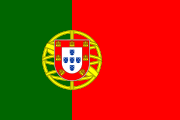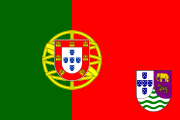
The hammer and sickle is a communist symbol representing proletarian solidarity between agricultural and industrial workers. It was first adopted during the Russian Revolution at the end of World War I, the hammer representing workers and the sickle representing the peasants.

"Angola Avante" is the national anthem of Angola. Ruy Mingas composed the music, while the lyrics were authored by Manuel Rui. It was adopted as the national anthem in November 1975, when the country gained its independence from Portugal. The lyrics make reference to several key events of the People's Movement for the Liberation of Angola (MPLA), which has been in power since independence and was the only party in Angola until 1992.
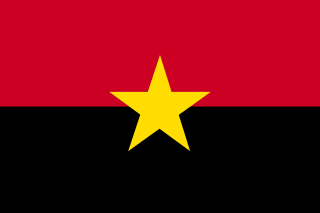
The People's Movement for the Liberation of Angola, for some years called the People's Movement for the Liberation of Angola – Labour Party, is an Angolan social democratic political party. The MPLA fought against the Portuguese Army in the Angolan War of Independence from 1961 to 1974, and defeated the National Union for the Total Independence of Angola (UNITA) and the National Liberation Front of Angola (FNLA) in the Angolan Civil War. The party has ruled Angola since the country's independence from Portugal in 1975, being the de facto government throughout the civil war and continuing to rule afterwards.

The president of Angola is both head of state and head of government in Angola. According to the constitution adopted in 2010, the post of prime minister is abolished; executive authority belongs to the president who has also a degree of legislative power, as he can govern by decree.

The State Flag of the Republic of the Union of Myanmar was adopted on 21 October 2010.

The national emblem of Cape Verde contains a circle within which is written the name of the nation in Portuguese. Within the circle are a torch and triangle, symbols of freedom and national unity. At the top of the shield is a plumbob, a symbol of righteousness; three chain links are at the bottom. This emblem replaces the earlier variant with the seashell that had been in use since independence. The current emblem was adopted in 1999.

The national emblem of Angola is the national emblem of Angola that reflects the recent past of the new nation. There is heavy Marxist imagery found on the device, expanded from what is found on the national flag.

The flag of Mozambique is the national flag of the Republic of Mozambique that was adopted on 1 May 1983. It is a tricolor flag with white fimbriations and a red triangle. Teal stands for the riches of the land, the white fimbriations signify peace, black represents the African continent, yellow symbolises the country's minerals, and red represents the struggle for independence. It includes the image of a Kalashnikov rifle with a bayonet attached to the barrel crossed by a hoe, superimposed on an open book. The rifle stands for defence and vigilance, the open book symbolises the importance of education, the hoe represents the country's agriculture, and the star symbolizes the spirit of the international solidarity of the Mozambican people. It is one of four national flags among UN member states that feature a firearm, along with those of Guatemala, Haiti and Bolivia, but is the only one of the four to feature a modern firearm instead of cannons or muskets.

The Angolan War of Independence, known as the Luta Armada de Libertação Nacional in Angola, began as an uprising against forced cultivation of cotton and evolved into a multi-faction struggle for control of Portugal's overseas province of Angola among three nationalist movements and a separatist movement. The war ended when a peaceful coup in Lisbon in April 1974 overthrew Portugal's Estado Novo dictatorship and the new regime immediately stopped all military action in the African colonies, declaring its intention to grant them independence without delay.

The national emblem of East Timor is one of the national symbols of East Timor.
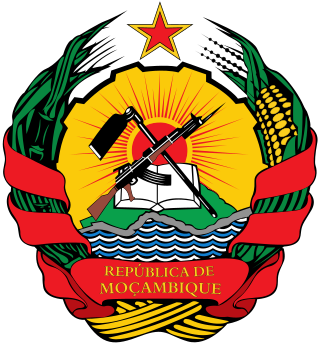
The national emblem of Mozambique was adopted in 1990 in the Constitution of Mozambique article 194. The article clearly states the design and meaning of the device. It shows a gear wheel, bordered by corn stalks and sugarcane. In the middle there is a red sun over a map of Mozambique in green, and blue waves, an AK-47 crossed with a hoe, and a book. The wreath is tied with a ribbon bearing the name of the country. The emblem is rendered in a socialist heraldry style similar to those used by the republics of the Soviet Union.

The Republic of Cabinda was an independent protectorate of Portugal that was taken over by Angola after Portugal declared Angola a free country. It is currently an unrecognized state, which Angola considers its Cabinda Province property. The Front for the Liberation of the State of Cabinda-Exército de Cabinda (FLEC) claimed sovereignty just after the Republic of Cabinda was proclaimed as an independent country in 1975 from Portugal and just after Angola invaded. The government of this entity operates in exile, with offices located in Paris, France, and Pointe Noire, Republic of the Congo.
Lúcio Rodrigo Leite Barreto de Lara, also known by the pseudonym Tchiweka, was a physicist-mathematician, politician, professor, anti-colonial ideologist and one of the founding members of the Popular Movement for the Liberation of Angola (MPLA). He served as General Secretary of the MPLA during the Angolan War of Independence and Angolan Civil War. Lara, a founding member of the MPLA, led the first MPLA members into Luanda on 8 November 1974. He swore in Agostinho Neto as the first president of the country.

Since its independence from Portugal in 1975, Angola has had three constitutions. The first came into force in 1975 as an "interim" measure; the second was approved in a 1992 referendum, and the third one was instituted in 2010.

The People's Republic of Angola was the self-declared socialist state which governed Angola from its independence in 1975 until 25 August 1992, during the Angolan Civil War.
The Republican Party of Angola - Conservative Party is an anti-corruption political party in Angola that strongly opposes the Popular Movement for the Liberation of Angola (MPLA), which has ruled the country since 1975.

The national emblem of North Macedonia depicts two curved garlands of sheaves of wheat, tobacco leaves and opium poppy fruits, tied by a ribbon decorated with embroidery of traditional Macedonian folk motifs. In the center of the ovoid frame are depicted a mountain, a lake and a sunrise. The features of the national coat of arms contain a rising sun which symbolizes freedom, the Šar Mountains with its peak named Ljuboten or Mount Korab and the river Vardar, with Lake Ohrid. The emblem also contains opium poppy fruits; this poppy was brought to the area during Ottoman times in the first half of the 19th century. Until 16 November 2009, the emblem also depicted a socialistic five-pointed star in the top. This emblem had been in use since 1946, shortly after the republic became part of Yugoslavia.
Communist symbolism represents a variety of themes, including revolution, the proletariat, the peasantry, agriculture, or international solidarity. The red flag, the hammer and sickle and the red star or variations thereof are some of the symbols adopted by communist movements, governments, and parties worldwide.
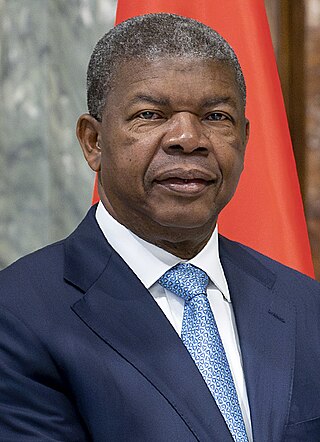
João Manuel Gonçalves Lourenço is an Angolan politician who has served as the 3rd president of Angola since 26 September 2017. Previously, he was Minister of Defence from 2014 to 2017. In September 2018, he became the Chairman of the People's Movement for the Liberation of Angola (MPLA), the ruling party. He was the party's Secretary-General from 1998 to 2003.



